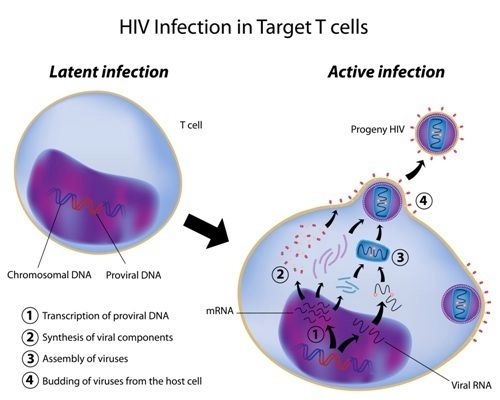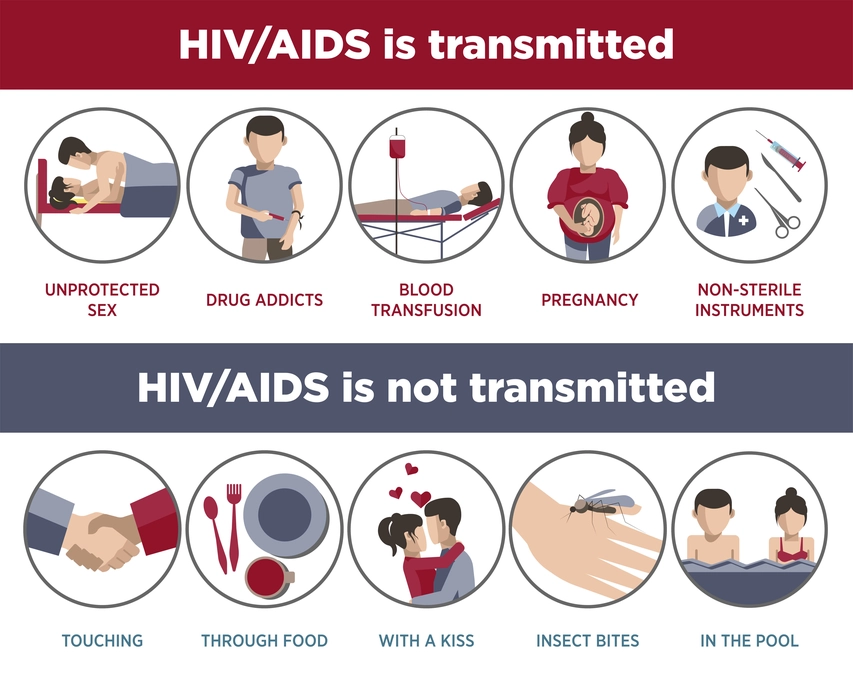Introduction
Viruses are small highly contagious creatures which live on the threshold of life and death. The most distinguishing characteristic of viruses is to multiply inside the living cells of other species. When this virus enters our bodies, it affects our immune systems, hence weakening us. When viruses enter our body they use the host mechanism to carry out their life process, as a result, the host(human) does not get the required energy and becomes weak. Viruses such as HIV majorly infect the cells of the immune system making them more susceptible to various other diseases.
HIV
HIV stands for Human Immunodeficiency Virus and is a small virus which belongs to a group of viruses known as retroviruses. This organism is the cause of AIDS. Human immune cells, also referred to as white blood cells(specifically the Helper T Cells), get infected by HIV, hence compromising the host’s immunity.
Process of infection of HIV
The HIV infection occurs when the blood of the infected person mixes with the blood of the healthy person. A virus enters the body following is the process of infection.
- When HIV first enters a person’s body, it locates and attaches to CD4 lymphocytes, which are essentially fighting cells of the immune system.
- The virus attaches and then releases its RNA into the cell.
- The retroviruses then synthesis DNA from RNA by the enzyme reverse transcriptase.
- The viral DNA fuses with the lymphocyte’s cellular DNA and becomes a part of the genetic makeup of the cell.
- The virus now creates a large number of its own copies using the cell’s replication system, which are then released into the blood to infect additional CD4 cells.
As the body number of CD4 cells in the body decreases due to the infection, the body becomes immunodeficient.

| AIDS | HIV |
| AIDS stands for Acquired Immunodeficiency Syndrome. | HIV stands for Human Immunodeficiency Virus. |
| AIDS is caused by Human Immunodeficiency Virus. | HIV is a virus that causes diseases. |
| AIDS is an immunodeficiency syndrome and is the last stage of HIV infection. | The virus infects the immune system and hence compromises the immune system of the host. |
| Patients show very severe symptoms. | Patients experience minor symptoms during acute and chronic infection stages. |
| Symptoms include- Breathlessness, lack of strength, swelling in groin regions, getting sick very easily, etc. | Symptoms are- Fever, nausea, body ache, stomach ache, etc. |
| It is incurable and fatal | Its infection can be controlled to some extent with the help of medicines. |
Summary
AIDS is currently quite common disease around the world. This condition is frequently taboo and not discussed in many societies, which unintentionally hastened its rapid global expansion. AIDS and HIV are frequently mistaken for one another, leading to their interchangeability. Despite being closely linked, they are not one and the same. It is important to note that AIDS is not particularly contagious on its own, which means that it cannot travel quickly through regular channels like air, water, etc. Hugs, sneezes, saliva, sweat, or proximity to infected people do not spread it.

Frequently Asked Questions
1. Explain detection of AIDS by ELISA Test?
Ans: Enzyme-Linked Immunosorbent Assay, known as ELISA, is a technique for identifying HIV infection. A viral protein antigen has already been generated in a laboratory. This antigen is placed in the cassette along with the blood sample of the patient. If the blood has viral antibodies, they attach to the antigen and coagulate hence modifying the look of the cassette’s contents which detects the presences of virus in the blood sample.
2. How is AIDS treated?
Ans: Antiretroviral therapy, generally known as ART, is a form of treatment for AIDS but is not a cure. It has a combination of three distinct drugs. It lengthens the afflicted person’s life span.
3. What distinguishes an antigen from an antibody?
Ans: Foreign chemicals are known as antigens and they have the power to infect the body and cause a disease. Pathogens frequently contain them.
Immune cells create immunoglobulins called antibodies to fight off particular antigens which are present in the host body cells.